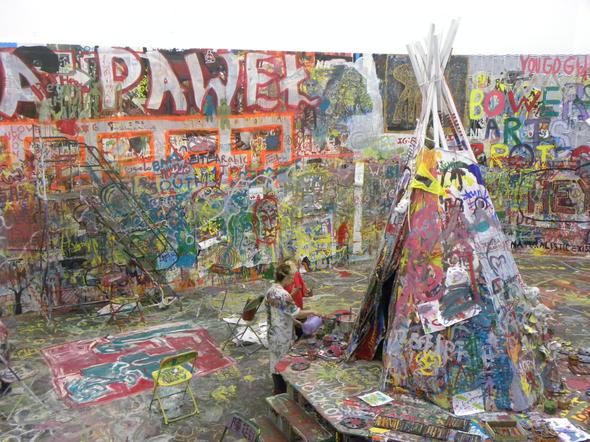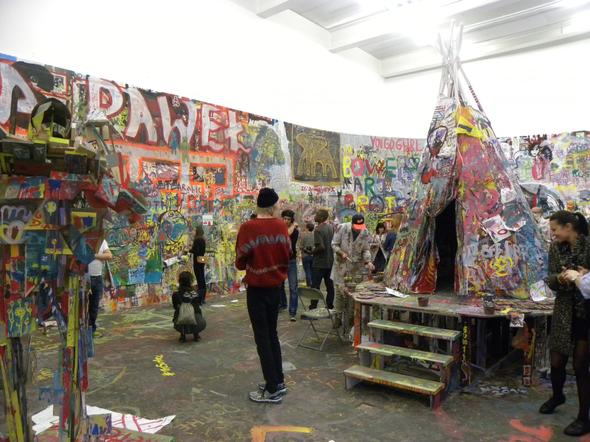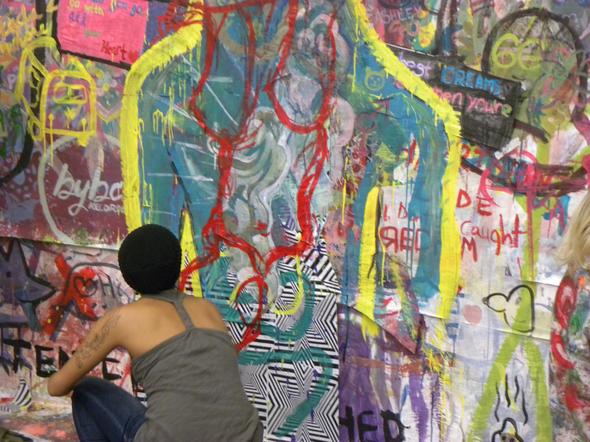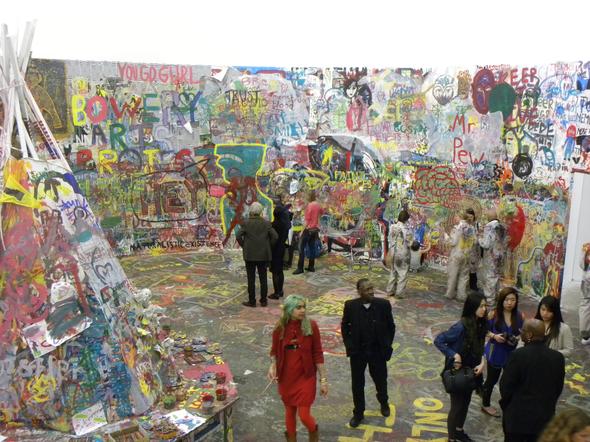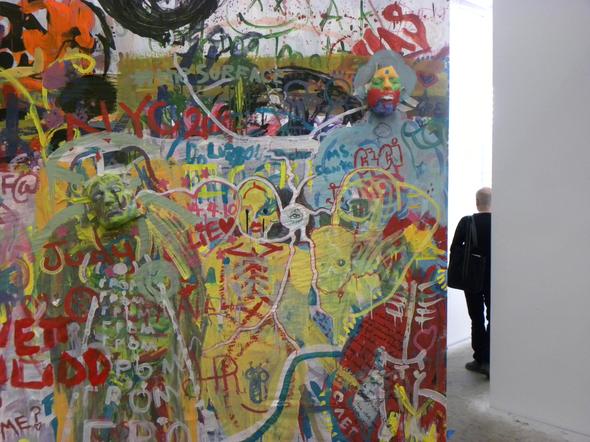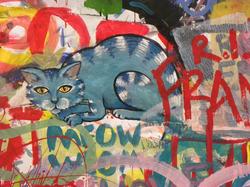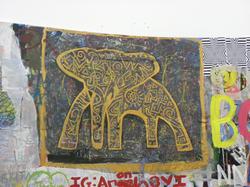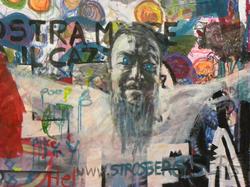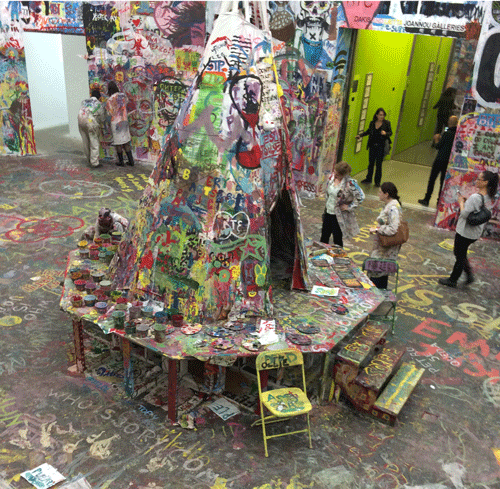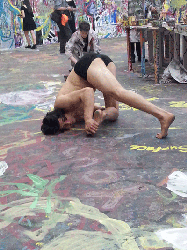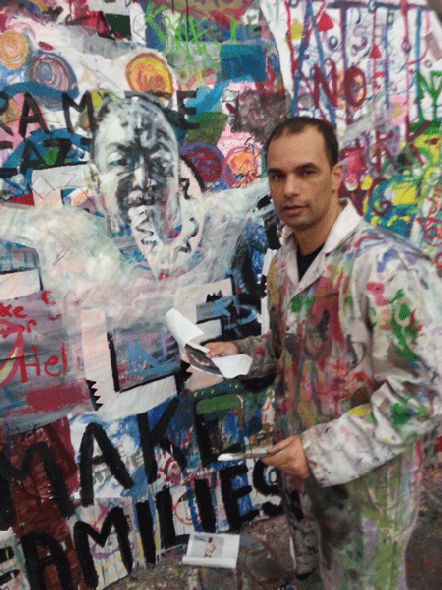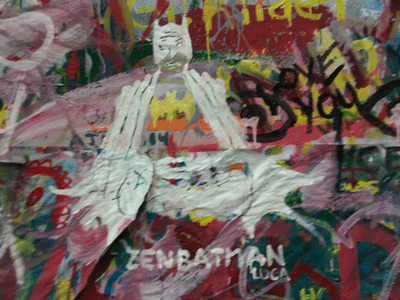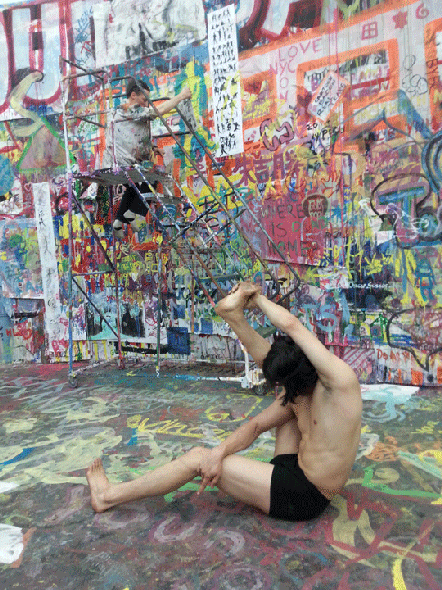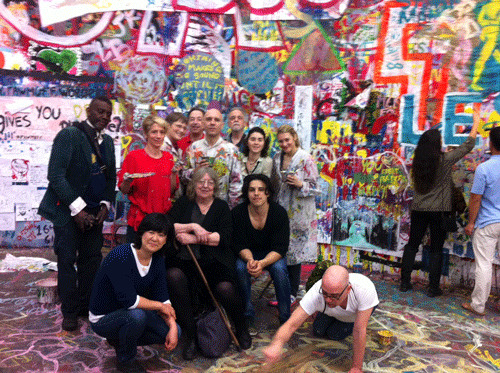
-- A Cyberspace Review Of The Arts
|
IN BRIEF |
Vivian Maier Documentary See the Vivian Maier Newsletter for the story about the new documentary. Our review of Vivian Maier's work is here. |
|
The Draughtsman's Congress There are three parts to this story. First, there is the official statement about what was going on, in the larger, abstract, institutional sense: http://www.newmuseum.org/exhibitions/view/pawel-althamer. I will not say any more about its history, origins, or intentions, since that is all I know about them. Second, my personal account, which follows immediately below. Third, Minerva Durham's account. She is, of course, the proprietor of Spring Studio, and we (see her article for all the names) were invited to this event as habitués of Spring Studio. Most of us draw there; some are models.
Congressing with the Draughtsmenby Gordon FitchI was invited to participate in the 'Draughtsman's Congress' through Spring Studio. The announcement and URL were about all the information I had. (I imagined the instigator, a Pole, whose language has some oddly decorated letters, which yet more or less follow the sounds they represent, rather savouring the irrational English spelling of 'draftsman', whose gh bespeaks an ancient guttural which, failing to disappear like its sisters in caught and taught, has migrated to the front of the mouth and, hanging from the teeth, turned into a mysterious f waving at the outer world. I noticed also that the imagined draughtsman was supposed to be manly and singular, approaching the 'Congress' as an individual, rather than some horde of indeterminate collectivized draughtsbeings. Between that individual and the concepts of congress, of collaboration, then, there was a certain tension.) Among other things, the prospectus specified that all sorts of materials would be supplied and we were not to show up with any. Hence, I dutifully appeared without supplies or preconceptions at the New Museum at the appointed time. Wandering around the museum's slick lobby -- a strange environment for those who knew the Bowery in the bad old days -- I eventually found the other members of my group, and after some bureaucracy, we made our way to the 4th floor where we found the general project in full flight. The walls and floor had been covered with pictures and words; the noise level was high. There were a lot of people of all kinds there, including small children, chance visitors, artists, students, and so on; some painting or drawing, many wandering around, many merely looking on. In the center of the room was a round table with some painting and drawing materials on it, and a teepee, which provided additional surfaces inside and out. Nearby there was sculpture of a cubistic standing man or humanoid being, also providing many paintable surfaces.
In some cases, a number of layers could be discerned in spite of overpainting. For example, I observed a large green demon sort of creature grimacing upward toward the stratosphere. It had been painted over an area covered with some sort of op-art paper. When I first encountered this painting, there was also a deftly painted male torso including legs (but not feet) within it, but rather subtle and obscure. I called attention to it by painting a white outline around it and some rays shooting off in another direction from it. I implied, but did not paint in, head and feet, and backed off. Before very long, a young woman came along with some bright red paint and painted a larger, rather raunchy female nude around and over, but not obscuring, the torso, also within the demon. She omitted the head; maybe the demon's head was supposed to suffice. Somewhat later an older man came along and supplied the body with a vigorous tough-babe head in the same color. At this point that section of the wall had become a fully legible palimpsest of six different artists and at least three figures, all rather synchronized to one another; certainly a collaboration of sorts.
There were exceptions to this rule of effacement. I found that it was possible to slide under the table in the center of the room; its underside was mostly unused. Pretending I was Michaelangelo working on the Sistine chapel, I painted a large, soulful eye; then, feeling it might be lonely, a sensuous mouth with full lips not too far away. At this point I noticed someone had written 'IS THIS PLACE SAFE' and responded in the words of Rilke's famous poem Herbst (Autumn), 'Und doch ist einer, welcher dieses Fallen unendlich sanft in seinen Händen hält' -- 'Yet there is one who holds this falling forever safe within his hands.' (The project started in Germany, so a little German was only reasonable.) An earlier line in the poem reads 'And in the night, the heavy earth falls, down from all the stars, into aloneness' and when I emerged a woman was painting the word 'LONELINESS' on a part of the tepee. I told her about the poem under the table. She paused and gave it some thought and after a moment or two suggested that I go write another poem there, perhaps mistaking me for Mr. Rilke, and in any case evidently wishing to remain consistent in her specialty. Instead, I wandered off. Later I came back and painted a circle over 'LONELINESS' with a single small dot in it. (Miss Loneliness had departed.) Not long after that someone drew more circles within the circle around the dot, forming a target; indeed, often the lonely are targets. But then it was joined by other targets. One imagined they could gang up on something. Transformation transformed!
Needless to say, quite a few people chose to project their egos (What? Egotistical artists?) or business interests, and wrote their names, web sites, comments and slogans on the walls. A rather dignified gentlemen whose long white hair testified to his age and indefatigable hipness inscribed a large, crude obscenity in brilliant red across a ghostly Lenin, revisiting perhaps some long-gone junior high of the mind. As one can see in the pictures, some of this work was quite grandiose. Typically, most of it soon got decorated or obscured, just as in graffiti country. (Actual graffiti writers may have participated, but as spray cans were not permitted, they would have been unable to employ their tools of choice, and the distinctive styles of their world were not much in evidence. I think, though, that most hard-core graffitists would have found the scene a bit tame.) One of the Spring Studio group, Magic (see below), was not a primarily a painter or draughtsman here but a model. Nearly nude, he posed in many interesting and rather difficult postures (he is very good at this) until the authorities intervened; it seems that 'performances', at least by those not conventionally dressed, were forbidden. Before that, my colleagues painted aspects of him on the nearby wall and floor; after all, we do Life Drawing. We may have been frustrated in this, but at least, we had pushed the sacred envelope and obtained the rewarding experience of being told to stop doing something.
On the whole, the event had the air of a children's party more than some kind of serious engagement between artists about collaboration and competition as indicated in the announcement. Many of the participants were probably not artists in a professional or serious-amateur sense, so while the experience of doing art may have been entertaining and enlightening for them it was not tremendously striking. Indeed, many successful events of this sort have been held in public parks in New York City with similar but more down-home purposes in mind. The higher level of discourse proposed by the 'prospectus', the discussion and interaction between art-committed practitioners, could not be achieved, at least not within the limited compass of my brief witness.
An Afternoon at the Museum, or Pure Magicby Minerva Durham"Are you going to time me?" Magic (Paul Distefano) asked me as we walked along Spring Street towards the New Museum of Contemporary Art to participate in the Draughtsman's Congress on the fourth floor. For over two months now the public and groups assigned a time slot, like us, had been painting and drawing on the walls and floors of the fourth floor with any imagery that they wanted, newcomers essentially obliterating the work of previous participants. The project had originated in Berlin, the idea of an avant-garde and political Polish artist, Pavel Althamer, whose work is on display in the Museum. "Sorry, I didn't bring a timer. Do you mind timing your poses yourself?" I asked. "Can I do anything I want? Any length of pose? Because I can try out lots of things that I couldn't do if there is a time limit." I hadn't told the Museum people that I was bringing a model. Magic draws too, so he could participate as artist or model if there were any objection. "I didn't bring the dance strap," he said., "I'm going to pose in black under-shorts instead." Seventeen artists from Spring Studio met at the reception desk and checked jackets and bags. We were told that the person who was to greet us and take us upstairs was too busy, so we were on our own. Easy enough. As we entered the room we were surrounded by color, layers of paint everywhere on the walls and the floor. Luca Mosca, Christa Pietrini, Harumi Osawa, Joseph Schwarz, Anne Simmons, Serge Strosberg and Catrin Treadwell put on paint-stained painters' coats and suits provided by the Museum.
All along Charles Johnson was taking thousands of photos. I will send some of his masterpieces after we download them. Here is a group photo of most of Spring Studio's delegation:
More at http://minervagoesnew.lucamosca.com/.... |
||||||||||||||||||||||||||||||||||||

